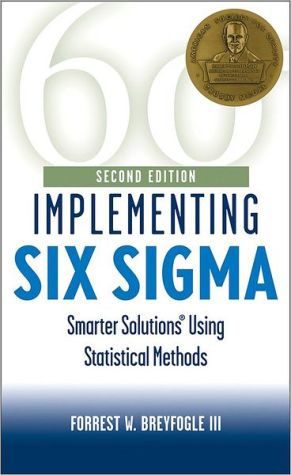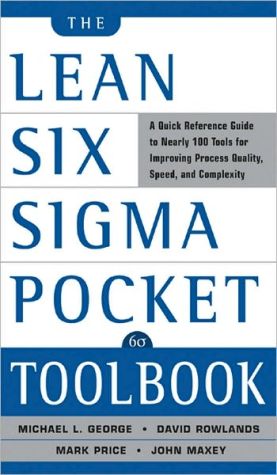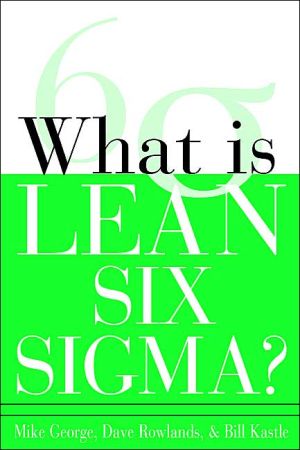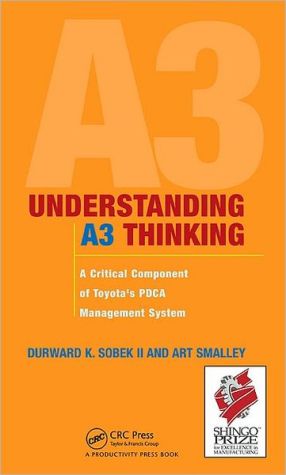Implementing Six Sigma: Smarter Solutions Using Statistical Methods: Second Edition
Includes new and expanded coverage of Six Sigma infrastructure building and benchmarking.\ Provides plans, checklists, metrics, and pitfalls.\
Search in google:
Written to aid organizations in laying the foundation for Six Sigma, this comprehensive and engaging guide provides the tools, strategies, and motivation to get all relevant players involved with improvement from upper management on down. At the heart of the book is a group of statistical tools that address FMEA (Failure Mode and Effect Analysis), QFD (Quality Functional Deployment), and DOE (Design of Experiment). Rather than offering just a brief overview, Implementing Six Sigma devotes individual chapters to all of the tools, so as to provide an in-depth analysis of each. A large selection of diagrams and clarifying exercises demonstrate how to best utilize the tools to successfully minimize defects throughout the production process. To provide a deeper understanding, the book discusses the theories of Edward Deming and the history of the Six Sigma program. Steeped in real world application, it presents numerous examples, as well as copies of actual implementation guides used by Motorola. Ramon V. Leon Associate Professor, Statistics Department of the University of Tennessee Associate editor, Six Sigma Forum magazine - "No other book covers-at an adequate technical level-as many topics important to Six Sigma. An indispensable reference for the Six Sigma practitioner."
PREFACE. PART I: S4/IEE DEPLOYMENT AND DEFINE PHASE FROM DMAIC. 1. Six Sigma Overview and S4/IEEE Implementation. 2. Voice of the Customer and the S4/IEEE Define Phase. PART II: S4/IEE MEASURE PHASE FROM DMAIC. 3. Measurement and the S4/IEEE Measurement Phase. 4. Process Flow Charting/Process Mapping. 5. Basic Tools. 6. Probability. 7. Overview of Distributions and Statistical Processes. 8. Probability and Hazard Plotting. 9. Six Sigma Measurements. 10. Basic Control Charts. 11. Process Capability and Process Performance Metrics. 12. Measurement Systems Analysis. 13. Cause-and-Effect Matrix and Quality Function Deployment. 14. FMEA (Failure Mode and Effects Analysis). PART III: S4/IEE ANALYZE PHASE FROM DMAIC (OR PASSIVE ANALYSIS PHASE). 15. Visualization of Data. 16. Confidence Intervals and Hypothesis Tests. 17. Inferences: Continuous Response. 18. Inference: Attribute (Pass/Fail) Response. 19. Comparison Tests: Continuous Response. 20. Comparison Tests: Attribute (Pass/Fail) Response. 21. Bootstrapping. 22. Variance Components. 23. Correlation and Simple Linear Regression. 24. Single-Factor (One-Way) Analysis of Variance (ANOVA) and Analysis of Means (ANOM). 25. Two-Factor (Two-Way) Analysis of Variance. 26. Multiple Regression, Logistic Regression, and Indicator Variables. PART IV: S4/IEE IMPROVE PHASE FROM DMAIC (OR PROACTIVE TESTING PHASE). 27. Benefiting from Design of Experiments (DOE). 28. Understanding the Creation of Full and FractionalFactorial 2K DOEs. 29. Planning 2K DOEs. 30. Design and Analysis of 2K DOEs. 31. Other DOE Considerations. 32. Robust DOE. 33. Response Surface Methodology. PART V: S4/IEE CONTROL PHASE FROM DMAIC AND APPLICATION EXAMPLES. 34. Short-Run and Target Control Charts. 35. Control Charting Alternatives. 36. Exponentially Weighted Moving Average (EWMA) and Engineering Process Control (EPC). 37. Pre-Control Charts. 38. Control, Plan, Poka-Yoke, Realistic Tolerancing, and Project Completion. 39. Reliability Testing/Assessment: Overview. 40. Reliability Testing/Assessment: Repairable System. 41. Reliability Testing/Assessment: Nonrepairable Devices. 42. Pass/Fall Functional Testing. 43. S4/IEEE Application Examples. PART VI: S4/IEE LEAN AND THEORY OF CONSTRAINTS. 44. Lean and Its Integration with S4/IEEE . 45. Integrating of Theory of Constraints (TOC) in S4 /IEE. PART VII: DFSS AND 21-STEP INTEGRATION OF THE TOOLS. 46. Manufacturing Applications and A 21-Step Integration of the Tools. 47. Service/Transactional Applications and A 21-Step Integration of the Tools. 48. DFSS Overview and Tools. 49. Product DFSS. 50. Process DFSS. PART VIII: MANAGEMENT OF INFRASTRUCTURE AND TEAM EXECUTION. 51. Change Management. 52. Project Management and Financial Analysis. 53. Team Effectiveness. 54. Creativity. 55. Alignment of Management Initiatives and Strategies with S4/IEEE . Appendix A. Supplemental Information. Appendix B. Equations for the Distributions. Appendix C. Mathematical Relationships. Appendix D. DOE Supplement. Appendix E. Reference Tables. List of Symbols. Glossary. References. Index.
\ From Barnes & NobleThe Barnes & Noble Review\ If you are involved in achieving bottom-line benefits and improved customer relationships for your organization, you don't want to miss this second edition of Implementing Six Sigma. This edition of the book takes the reader well beyond the traditional Six Sigma approach (consisting of six levels: knowledge, comprehension, application, analysis, synthesis, and evaluation) with an enhanced version that integrates other performance improvement techniques. Forrest W. Breyfogle calls this new approach Smarter Six Sigma Solutions (S4) Integrated Enterprise Excellence (IEE) or S4/IEE. \ The book is divided into eight parts that cover S4/IEE, including measurement, analysis, implementation, control, integration, and management. For example, Part I describes the deployment of the S4/IEE implementation with a knowledge-centered activity (KCA) focus and the benefits. Parts II to V describe the measure-analyze-improve-control phases of define-measure-analyze-improve-control (DMAIC). Finally, parts VI to VIII describe other aspects for a successful S4/IEE implementation. Furthermore, this book is extremely thorough and well written, including an excellent set of exercises all along the way that provide a means of transforming information into virtual practical experience. John Vacca\ John Vacca, the former computer security official (CSO) for NASA's space station program (Freedom), has written 38 books about advanced storage, computer security, and aerospace technology.\ \ \ \ \ \ From the Publisher"The book is process oriented rather than tool oriented. This makes it refreshing and useful. This is a book every reliability engineer should own." (Reliability Review; 12/08)\ "An excellent reference book that should be on every individual involved in Six Sigma or even just quality assurance/quality improvement." (TQM Magazine)\ "...a useful guide for both academia and organizations...useful source of reference for researchers...an excellent reference book..." (The TQM Magazine, Vol 15(6) 2003)\ \ \ \ From The Critics"No other book covers-at an adequate technical level-as many topics important to Six Sigma. An indispensable reference for the Six Sigma practitioner." \ —Ramon V. Leon Associate Professor, Statistics Department of the University of Tennessee Associate editor, Six Sigma Forum magazine\ \ \ \ \ Publisher"Implementing Six Sigma provides the most up-to-date material on the topic, complete with a project infrastructure roadmap and hundreds of real-life examples and exercises."\ —Frank Shines Project Manager, Pilgrim Software\ \ \ \ \ John Wiley & Sons PublishingA business initiative first espoused by Motorola in the early 1990s, the Six Sigma strategy has become a standard statistical technique for quality improvement. Breyfogle, founder and president of a quality consulting firm, explains the implementation of Six Sigma. The text is divided into five sections centered on using his "Smarter Six Sigma Solutions" -- deployment, measurement, analysis, improvement, and control -- and includes examples that describe the mechanics of implementation as well as application possibilities. Annotation c. Book News, Inc., Portland, OR (booknews.com)\ \ "I have seen many Six Sigma approaches, but Breyfogle's Implementing Six Sigma is the most comprehensive of them all." --Frank Shines, Principal, IBM Global Services, Measurement Methods Consulting\ "The key to business success is doing the right thing faster and better and more efficiently than your competition. The Six Sigma approach aims at achieving this and Forrest Breyfogle has written the most systematic and comprehensive manual available on the subject." --Paul Tobias, Manager, Statistical Methods Group, SEMATECH\ "[This book] illustrates how most organizations can become more competitive, reduce defect levels, and improve cycle times. It consolidates not only the traditional Six Sigma process measurements and improvement tools, but also many other useful methodologies into one easy-to-understand text." --Bill Wiggenhorn, Senior Vice President of Motorola Training and Education; President, Motorola University\ \ \







